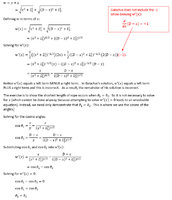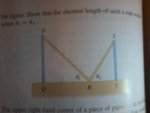Two vertical poles PQ and ST are secured by a rope PRS going from the top of the first pole to a point R on the ground between the poles to the top of the second pole as in the figure. Show that the shortest length of such a rope occurs when theta[sub:czxuwkxz]1[/sub=theta2[/sub:czxuwkxz]. Im not sure where to begin. should i use the fact that its an angle at 180 degrees on the bottom and then try to come up with something from there?
You are using an out of date browser. It may not display this or other websites correctly.
You should upgrade or use an alternative browser.
You should upgrade or use an alternative browser.
optimizing problems
- Thread starter janeann
- Start date
D
Deleted member 4993
Guest
janeann said:Two vertical poles PQ and ST are secured by a rope PRS going from the top of the first pole to a point R on the ground between the poles to the top of the second pole as in the figure. Show that the shortest length of such a rope occurs when theta[sub:1oemxymb]1[/sub=theta2[/sub:1oemxymb]. Im not sure where to begin. should i use the fact that its an angle at 180 degrees on the bottom and then try to come up with something from there?
I do not what level of mathematics are you studying now.
One way to solve this problem will be to define:
PQ = h[sub:1oemxymb]1[/sub:1oemxymb] = constant = L[sub:1oemxymb]1[/sub:1oemxymb]*sin(?[sub:1oemxymb]1[/sub:1oemxymb])...............................................(1)
ST = h[sub:1oemxymb]2[/sub:1oemxymb] = constant = L[sub:1oemxymb]2[/sub:1oemxymb]*sin(?[sub:1oemxymb]2[/sub:1oemxymb])................................................(2)
QR + RT = constant = L[sub:1oemxymb]1[/sub:1oemxymb]*cos(?[sub:1oemxymb]1[/sub:1oemxymb]) + L[sub:1oemxymb]2[/sub:1oemxymb]*cos(?[sub:1oemxymb]2[/sub:1oemxymb])................(3)
Minimizing function = L[sub:1oemxymb]1[/sub:1oemxymb] + L[sub:1oemxymb]2[/sub:1oemxymb]...............................................................(4)
Using Lagrangian method of undetermined constants, you can optimize (4) subjected to (1), (2) & (3) as constraints.
There are various ways to go about it. But, here is one way. May not be the most efficient, but it is OK.
This can also show the optimum distance to place the wire on the ground between the poles.
Let the distance between the poles be D. The other lengths are labeled in the diagram.
The total length of the wire is:
\(\displaystyle w=y+z\)
By Pythagoras, \(\displaystyle y=\sqrt{x^{2}+L_{1}^{2}}\)
\(\displaystyle z=\sqrt{(D-x)^{2}+L_{2}^{2}}\)
\(\displaystyle \frac{dw}{dx}=\frac{x-D}{\sqrt{x^{2}-2xD+D^{2}+L_{2}^{2}}}+\frac{x}{\sqrt{x^{2}+L_{1}^{2}}}\)
Setting to 0 and solving for x gives \(\displaystyle x=\frac{L_{1}D}{L_{1}+L_{2}}\)
\(\displaystyle D-x=\frac{L_{2}D}{L_{1}+L_{2}}\)
Now, this is the optimum distance of x where the wire should be on the ground.
\(\displaystyle cot({\theta}_{1})=\frac{L_{1}D}{L_{1}(L_{1}+L_{2})}, \;\ cot({\theta}_{2})=\frac{L_{2}D}{L_{2}(L_{1}+L_{2})}\)
The angle are the same.
This can also show the optimum distance to place the wire on the ground between the poles.
Let the distance between the poles be D. The other lengths are labeled in the diagram.
The total length of the wire is:
\(\displaystyle w=y+z\)
By Pythagoras, \(\displaystyle y=\sqrt{x^{2}+L_{1}^{2}}\)
\(\displaystyle z=\sqrt{(D-x)^{2}+L_{2}^{2}}\)
\(\displaystyle \frac{dw}{dx}=\frac{x-D}{\sqrt{x^{2}-2xD+D^{2}+L_{2}^{2}}}+\frac{x}{\sqrt{x^{2}+L_{1}^{2}}}\)
Setting to 0 and solving for x gives \(\displaystyle x=\frac{L_{1}D}{L_{1}+L_{2}}\)
\(\displaystyle D-x=\frac{L_{2}D}{L_{1}+L_{2}}\)
Now, this is the optimum distance of x where the wire should be on the ground.
\(\displaystyle cot({\theta}_{1})=\frac{L_{1}D}{L_{1}(L_{1}+L_{2})}, \;\ cot({\theta}_{2})=\frac{L_{2}D}{L_{2}(L_{1}+L_{2})}\)
The angle are the same.
Attachments
Hello, janeann!
There is a non-Calculus solution which is guaranteed to infuriate your teacher.
\(\displaystyle \text{We want to minimize the distance } d \,=\,PR + RS.\)
\(\displaystyle \text{Reflect point }S\text{ across the ground-line }QT\text{ to point }S'.\)
\(\displaystyle \text{Then draw }PS'\text{, intersecting }QT\text{ at }R.\)
\(\displaystyle \text{Since }\Delta STR \cong \Delta S'TR,\;d\:=\ R + RS \:=\
R + RS \:=\ R + RS'.\)
R + RS'.\)
\(\displaystyle \text{And }\,d\:=\ R + RS'\,\text{ is a minimum when }PRS'\text{ is a straight line.}\)
R + RS'\,\text{ is a minimum when }PRS'\text{ is a straight line.}\)
\(\displaystyle \text{Since }\theta_1\text{ and }\theta_2\text{ are vertical angles: }\:\theta_1 \:=\:\theta_2\)
Warning: Do not do this on a Calculus exam!
\(\displaystyle \text{Two vertical poles }PQ\text{ and }ST\text{ are secured by a rope }PRS\)
\(\displaystyle \text{going from the top of the first pole }(P)\text{ to a point }R\text{ on the ground between the poles}\)
\(\displaystyle \text{to the top of the second pole }(S)\text{ as in the figure.}\)
\(\displaystyle \text{Show that the shortest length of such a rope occurs when }\theta_1 =\theta_2\)
Code:P o | * | * o S | * * | | * * | | @1 * * @2 | Q o - - - - - o - - - o T R *
There is a non-Calculus solution which is guaranteed to infuriate your teacher.
\(\displaystyle \text{We want to minimize the distance } d \,=\,PR + RS.\)
\(\displaystyle \text{Reflect point }S\text{ across the ground-line }QT\text{ to point }S'.\)
Code:
P *
|
| * S
| |
| |
| |
Q * - - - - - - - - - * T
|
|
|
* S'\(\displaystyle \text{Then draw }PS'\text{, intersecting }QT\text{ at }R.\)
Code:
P *
| *
| * o S
| * . '
| * . '
| @1 * . '
Q * - - - - - * - - - * T
R * @2 |
* |
* |
* S'\(\displaystyle \text{Since }\Delta STR \cong \Delta S'TR,\;d\:=\
\(\displaystyle \text{And }\,d\:=\
\(\displaystyle \text{Since }\theta_1\text{ and }\theta_2\text{ are vertical angles: }\:\theta_1 \:=\:\theta_2\)
Warning: Do not do this on a Calculus exam!
ian000bell
New member
- Joined
- Jan 21, 2021
- Messages
- 1
The answer provided by Galactus is wrong. He makes the error when deriving dw/dx
which he shows to be the sum of 2 terms. This should be the subtraction of 2 terms.

Again, we do not solve for x but simply show the first and second angles are the same. I am a calculus newbie and am working my way through a Stewart calculus textbook.
which he shows to be the sum of 2 terms. This should be the subtraction of 2 terms.

Again, we do not solve for x but simply show the first and second angles are the same. I am a calculus newbie and am working my way through a Stewart calculus textbook.


